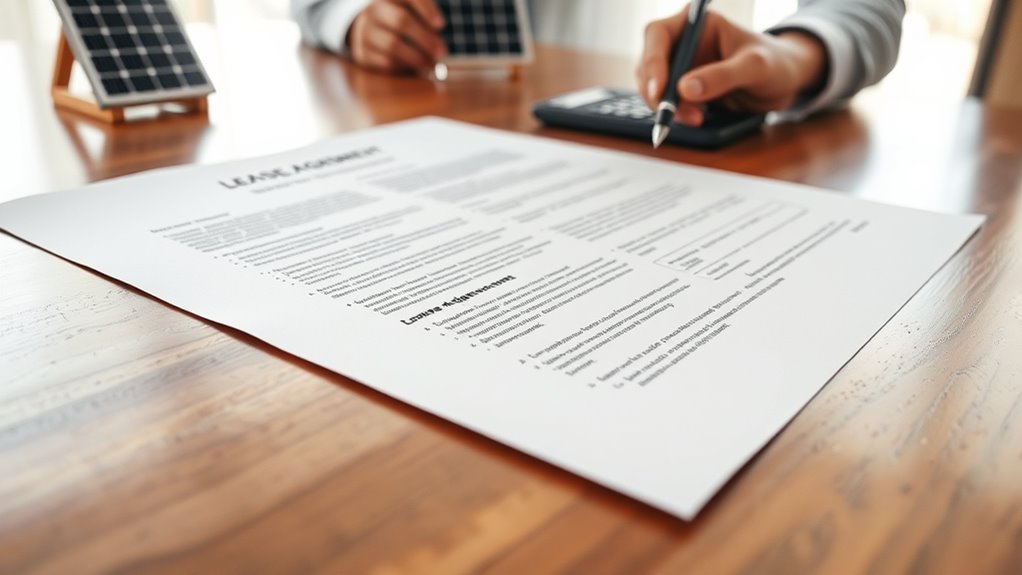Rent-to-own solar agreements can hide costs like escalator clauses that raise payments annually, residual or buyout fees at the end, and maintenance responsibilities that may surprise you. You might also face transfer restrictions if you sell your property, and regional laws can impact contract terms or incentives. Understanding these hidden line-items helps you avoid surprises. Keep going to uncover what you need to know to make informed decisions and protect your investment.
Key Takeaways
- Hidden fees like buyout costs, residual payments, and early termination charges can significantly impact total expenses.
- Escalator clauses increase payments annually, affecting long-term affordability and overall system costs.
- Maintenance and repair responsibilities often favor providers, with costs bundled into fixed monthly payments.
- Transfer restrictions and additional fees may apply when selling or transferring the property with a solar lease or PPA.
- Regional laws and contract details influence transferability, warranties, and consumer protections, requiring careful review.
Understanding the Contract Term and Payment Schedule
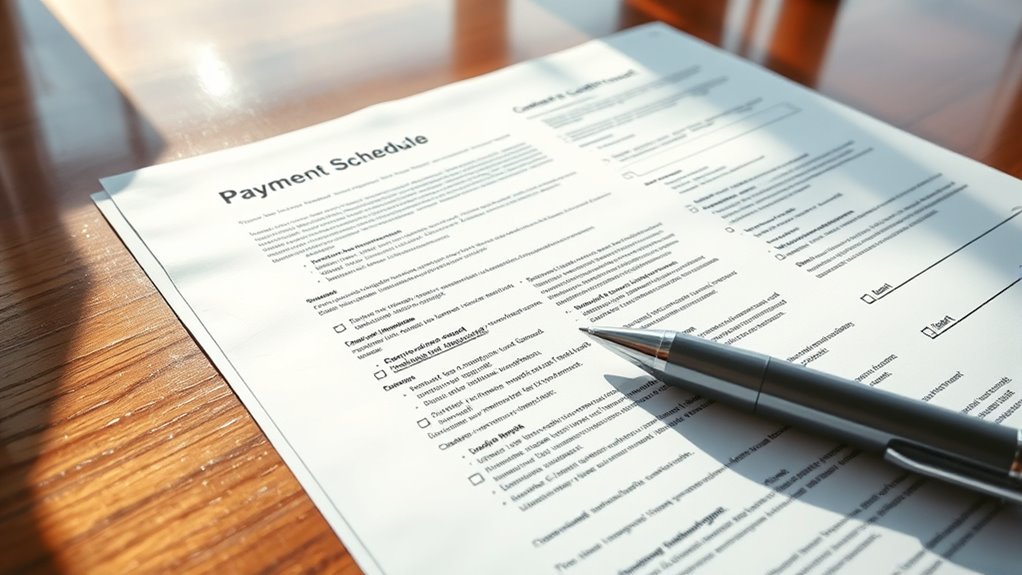
Understanding the contract term and payment schedule is essential when entering into a rent-to-own solar agreement. Lease terms usually range from 20 to 50 years, designed to recover costs and generate profit. Shorter leases are becoming more common but still need to cover project expenses. An option period, lasting from 1-2 up to 10 years, allows the solar company to evaluate your site before finalizing the lease. Payment schedules tend to be fixed monthly amounts, providing predictability, with some agreements allowing periodic increases. These payments, combined with your electric bill, should cost less than your previous electricity expenses, ensuring savings. Missing payments can lead to penalties or default. Understanding these terms helps you plan financially and avoid surprises during the lease. Additionally, it’s important to review the contract renewal options to understand what happens at the end of the lease term. Incorporating data-driven strategies can help you analyze your savings and make informed decisions about your solar investment.
Clarifying Maintenance and Repair Responsibilities
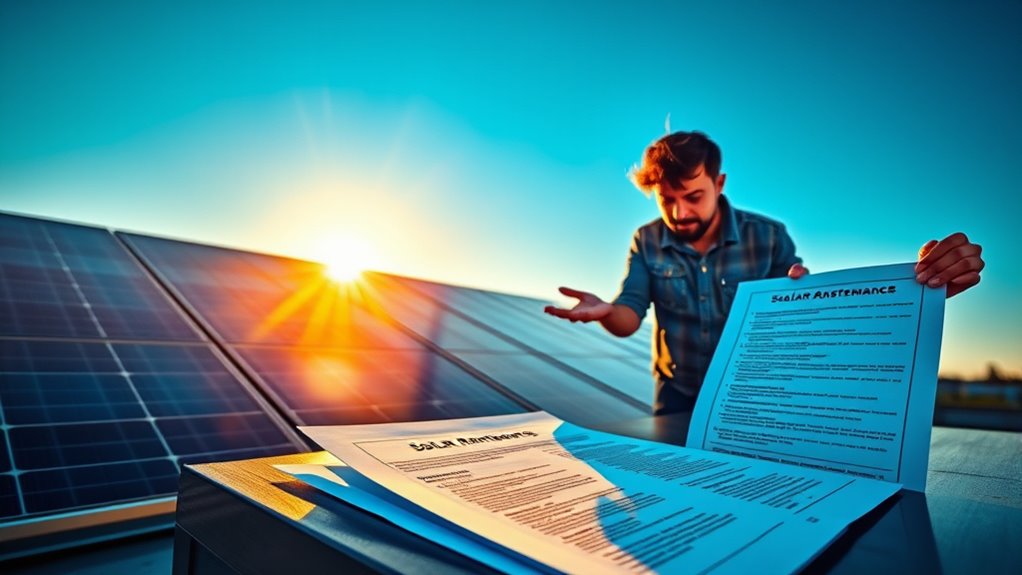
You should know who’s responsible for maintenance costs and repairs during your lease. Usually, the solar provider covers maintenance and repairs, but it’s essential to review your agreement to confirm these details. Clear understanding now helps you avoid surprises if issues arise later. Understanding system maintenance responsibilities is crucial to ensure you’re protected throughout the lease term. Additionally, paying attention to the performance guarantees included in your contract can offer further peace of mind regarding the system’s upkeep.
Maintenance Cost Responsibilities
In rent-to-own solar agreements, the solar provider typically takes on most maintenance and repair responsibilities, easing your burden. They handle routine maintenance, system monitoring, and emergency repairs for the entire lease duration, often at no upfront cost to you. This arrangement guarantees your system remains efficient without unexpected expenses. Many agreements include extended warranties you can purchase for coverage beyond the initial warranty period, helping manage long-term costs. Since maintenance costs are bundled into your monthly payments, you won’t face separate bills for repairs or servicing. This setup provides cost stability and peace of mind, as the solar company manages all operational concerns. Research shows that solar providers generally bear the responsibility for system upkeep, ensuring optimal performance throughout the lease. Just be sure to review your contract to understand specific maintenance responsibilities and any optional warranty coverage options. Additionally, understanding the maintenance and repair responsibilities outlined in your agreement can prevent surprises during your lease term.
Repair Service Terms
In rent-to-own solar agreements, the leasing company generally manages most maintenance and repair tasks, but it’s important to know the specific terms outlined in your contract. Here’s what to expect:
- Ownership: The leasing company owns the system and handles repairs, reducing your direct responsibility.
- Homeowner Duties: You’re usually responsible for maintaining your roof and ensuring access for repairs.
- Response Times: Contracts often specify how quickly the leasing company will respond to repair requests.
- Warranty & Extra Coverage: Solar panels come with warranties of 20–25 years, but you can buy extended warranties for additional protection.
Knowing these terms helps you understand your role and what’s covered during the lease.
End-of-Contract Buyout Options and Pricing
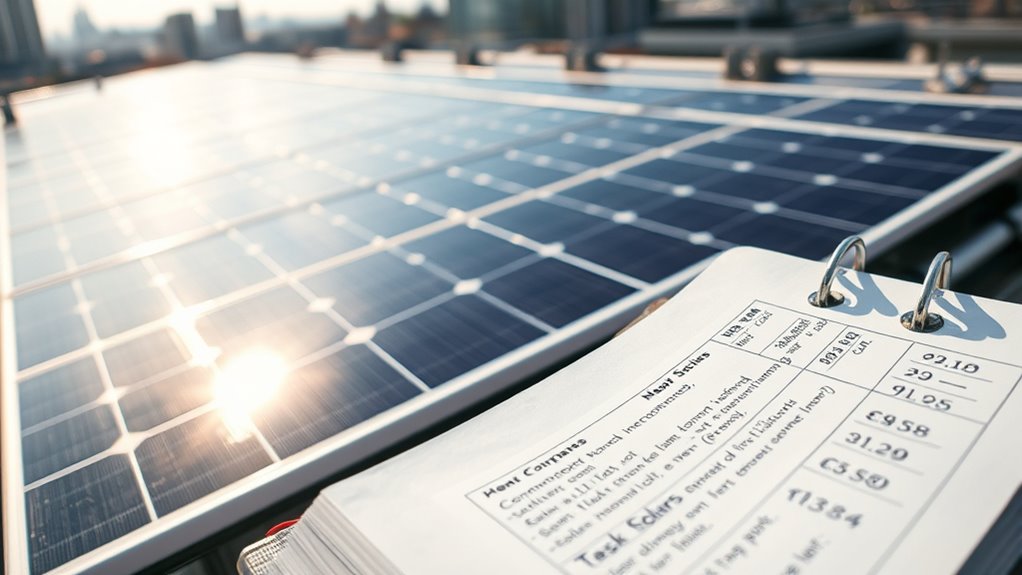
When the lease ends, you’ll need to contemplate your buyout options and the associated costs. The buyout price often depends on factors like system age, fair market value, and contract terms, including any tax credit repayments. Understanding how these components are calculated can help you decide if purchasing the system makes financial sense. Additionally, the buyout price may be influenced by the remaining value of the system and any residual lease payments owed. An understanding of the system’s lifespan can further clarify the remaining value and potential depreciation affecting the buyout amount.
Buyout Price Calculation
Determining the buyout price at the end of a rent-to-own solar agreement involves several key factors. First, the price might be a fixed amount specified in your lease or based on the system’s fair market value, which requires an appraisal considering age, condition, and performance. Second, some contracts include a schedule where buyout costs decrease over time, encouraging earlier buyouts. Third, depreciation and remaining useful life influence the valuation, especially for older systems. Fourth, the buyout may include outstanding lease payments plus the residual value of the system, factoring in any finance margins or interest embedded in the lease. Understanding these elements helps you anticipate costs and decide if buying out aligns with your long-term goals. Market fluctuations can also influence the final buyout price, especially as technology advances and system values shift. In addition, the cost of the system can fluctuate based on market conditions and technological advancements, affecting the final buyout price.
Conditions for Purchase
End-of-contract conditions for purchasing a rent-to-own solar system outline your options and the process involved. Typically, you can buy the system starting from the seventh year of your lease, with the price based on its fair market value. To exercise this option, you need to notify the provider in writing at least sixty days before your desired purchase date. You can request a price estimate up to ninety days prior, and if there’s a dispute over value, a professional appraiser will determine it, sharing costs. Once you pay the agreed price, ownership transfers to you, along with any transferable warranties. Some agreements allow early buyouts or lease transfers, but these often require approval and may involve additional costs or credit checks. Understanding the ethical hacking principles involved can help you better grasp the importance of transparency and security in these agreements.
Escalator and Price Adjustment Clauses

Escalator and price adjustment clauses are key components in rent-to-own solar agreements that directly impact your long-term costs. These clauses allow for periodic increases or adjustments based on market or inflation changes, influencing your overall expenses. Here’s what you need to know:
- Escalator clauses typically raise payments by 3-4% annually, gradually increasing your costs.
- Price adjustment clauses can alter energy or system costs, reflecting market trends or technological shifts.
- Both clauses impact buyout prices, potentially raising the final amount you pay at the end of the lease.
- Negotiating these clauses upfront helps you understand and control future costs, ensuring fairness in the agreement.
- Understanding how these clauses are calculated can help you better anticipate your total financial commitment over the lease period.
- Familiarity with preppy dog names and other breed-specific naming trends can also help in making informed decisions about your pet’s identity and personality.
Being aware of these clauses helps you evaluate the true financial implications of your solar lease.
Early Termination Conditions and Penalties
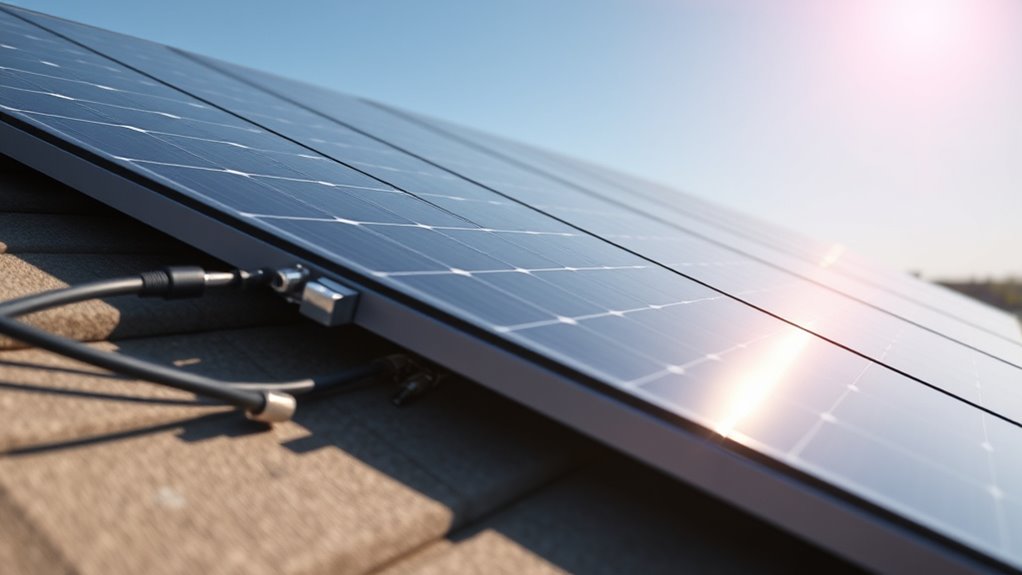
Understanding the conditions and penalties related to early termination is vital before signing a rent-to-own solar agreement. Typically, ending the contract early triggers significant fees designed to discourage premature cancellation. These may include an early termination fee, costs for system removal, or paying the remaining balance based on market value. Fees vary widely, often increasing with longer contracts, and hidden charges can appear if you don’t review terms carefully. Conditions prompting early termination include selling or moving, breaching payment obligations, or contract violations. Some agreements permit early termination without penalties, but these are rare. Be aware that legal language can be complex, potentially leading to disputes over ownership and responsibilities. Negotiating clear terms upfront and seeking legal advice can help you avoid costly surprises. Proper contract review is essential to understand the specific penalties and conditions that apply to your situation. Additionally, understanding exemption clauses can help you identify scenarios where penalties might be waived or reduced.
Transferability of the Agreement During Property Changes
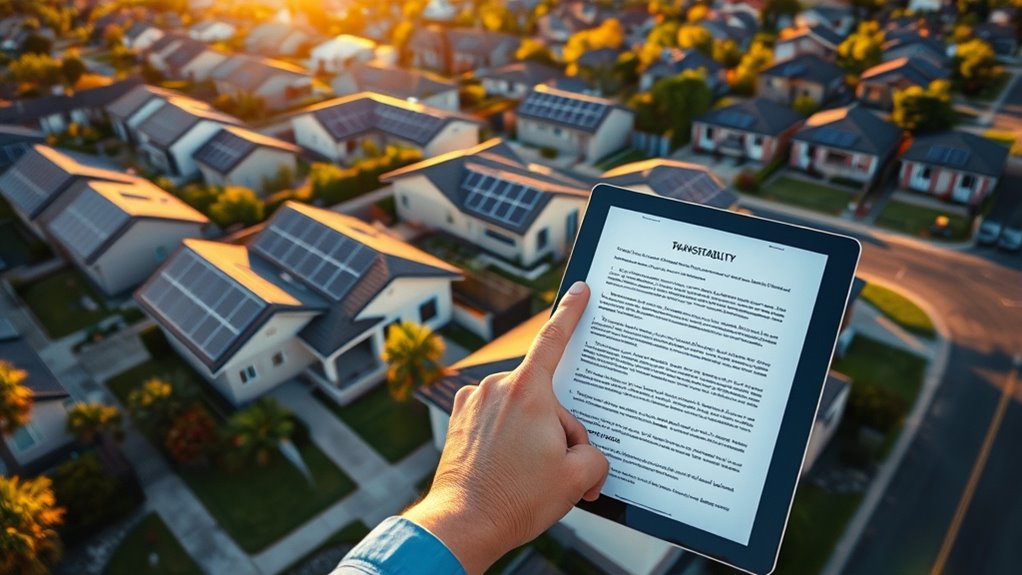
When property changes hands, transferring a rent-to-own solar agreement can become complex, depending on the ownership structure and the type of contract in place. Here’s what you need to know:
- If you own the system outright, it transfers automatically with the property, just like any fixture. Homes with owned solar systems typically see an increase in property value and marketability.
- Lease or PPA systems stay owned by the solar company; transferring requires provider approval and contract reassignment. Understanding the historical context of solar agreements can help clarify the transfer process.
- Loan-financed systems may need the new owner to qualify or pay off the remaining loan before transfer.
- Transfers often face restrictions—most companies only permit individuals, not entities like LLCs or corporations, to assume agreements, potentially delaying your sale.
Preparing complete documentation and early communication with the provider can streamline this process.
Incentives, Tax Credits, and Ownership Benefits
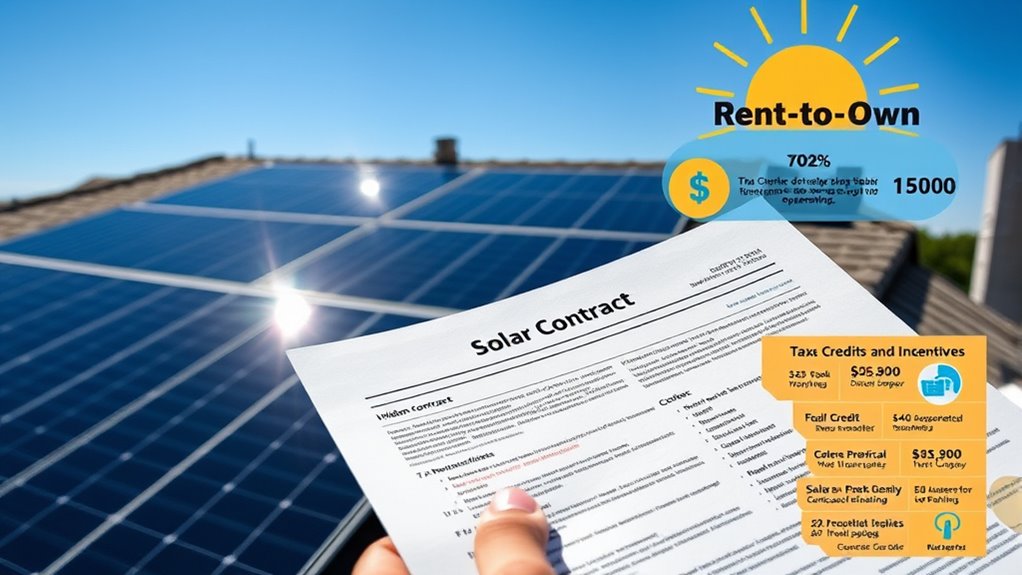
Owning a solar system through a rent-to-own agreement grants significant financial benefits, especially when it comes to incentives and tax credits. The federal Investment Tax Credit (ITC) offers a 30% credit on commercial solar costs, and since rental properties are considered commercial, owning the system makes you eligible. You must own the system outright; leasing disqualifies you from the ITC. The Residential Clean Energy Credit also applies to purchased solar systems, providing a 30% deduction until 2032. Ownership allows you to claim these credits, reducing your tax liability and lowering system costs. Plus, owning your system boosts property value, opens doors to additional local incentives, and offers control over maintenance and upgrades—all maximizing your long-term savings. Additionally, understanding solar system ownership is crucial to fully benefit from these financial advantages.
Regional Regulations and Their Impact on Terms
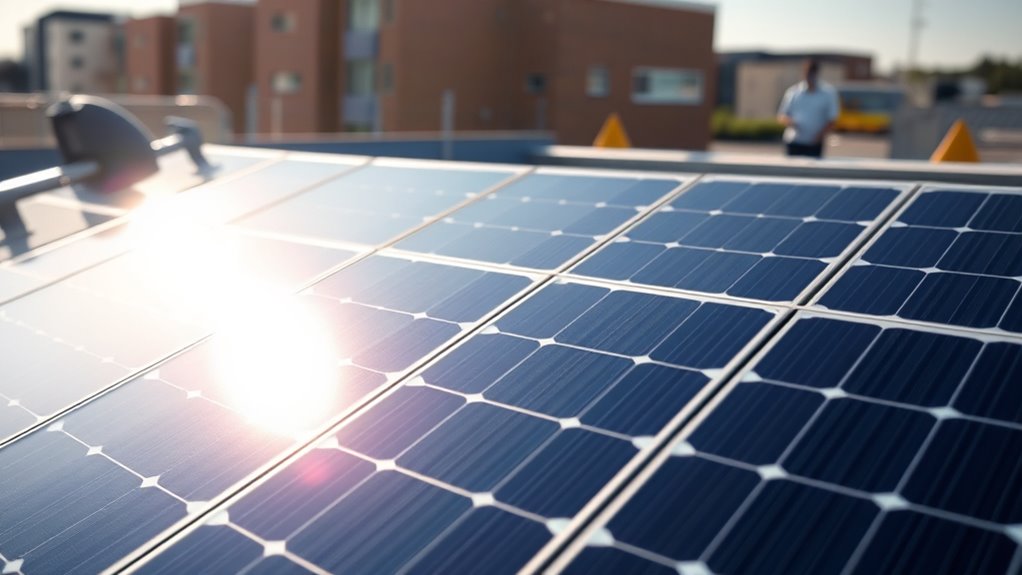
Regional regulations considerably influence the terms and feasibility of rent-to-own solar agreements. You’ll find that laws vary markedly by state, affecting key aspects like lease transferability and contract length. Here’s what to contemplate:
- Some states, like Virginia, set minimum credit scores, while others, like North Carolina, limit lease transfers.
- Regional rules impact HOA approval, with the Northeast requiring compliance with size and placement standards.
- The Southwest demands guarantees on energy production, influencing contract terms.
- Midwest states emphasize disclosure of utility rate changes, affecting long-term obligations.
These regulations shape your options, potentially limiting lease terms or transfer rights. Staying informed about local laws helps you navigate contract negotiations confidently and avoid surprises down the line.
Disclosures and Consumer Protections to Watch For
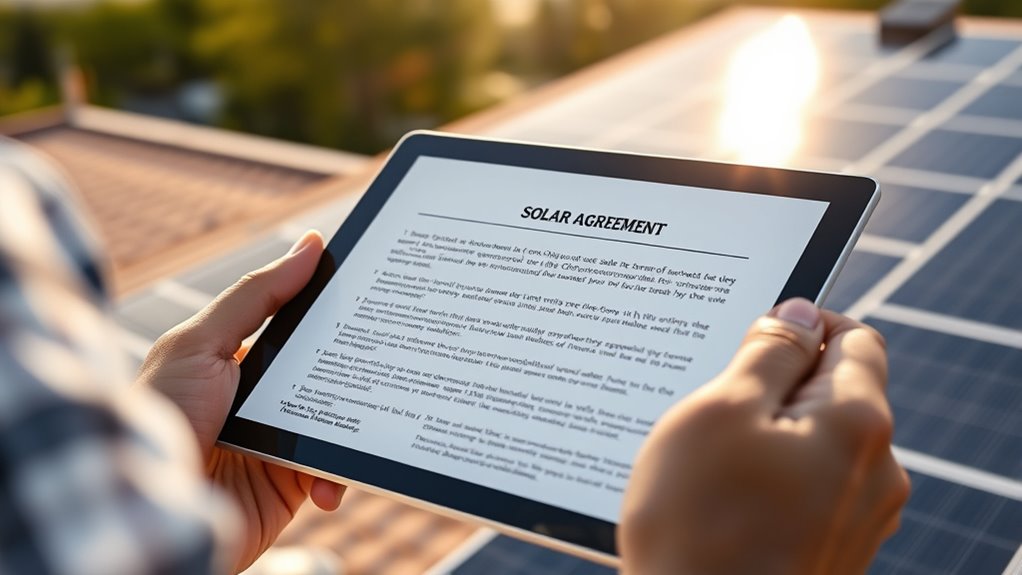
Have you ever wondered if you’re getting all the information you need before signing a rent-to-own solar agreement? It’s essential to review disclosures carefully. Look for details on total costs, payment terms, installation timelines, and warranty coverage. States require clear info on one-time and recurring fees to avoid surprises. Make sure the contract explains system size, expected savings, and generation assumptions. Watch for guarantees on system performance and procedures for resolving disputes. Consumer protections often include cooling-off periods, transfer clauses, and clear early termination terms to prevent hidden costs. Warranties should cover equipment and installation. Also, check disclosures about credits, rebates, and incentives. These details help you understand your financial commitments and protect you from misleading sales tactics. Researching the seller’s reputation can provide additional peace of mind and ensure you’re dealing with a reputable provider.
Frequently Asked Questions
Are There Hidden Fees or Costs Not Disclosed Upfront?
You might worry about hidden fees or costs hidden upfront. In rent-to-own solar agreements, you often face surprise expenses like annual price increases, cancellation fees, roof or electrical upgrades, and extra maintenance charges. These costs aren’t always clearly disclosed at the start. Additionally, you may pay for permits, insurance, or system removal later on, making it harder to budget and potentially reducing your expected savings.
How Does the Agreement Handle Property Damage or Remodeling?
When it comes to property damage or remodeling, your agreement should clearly define responsibilities, limit alterations, and specify restoration duties. You need to understand who handles repairs, covers costs, and manages damage from vandalism or natural events. Make certain the lease restricts modifications that could harm the solar equipment or land, and clarifies decommissioning obligations. Clear terms protect your property, reduce disputes, and facilitate smooth handovers at the end of the lease.
What Are the Specific Legal Rights if the Company Goes Bankrupt?
When a company goes bankrupt, your legal rights depend on the type of bankruptcy filed. You’re protected by an automatic stay that halts repossession and collection efforts during the case. If you’re in a Chapter 13, you might renegotiate payment plans and keep the equipment. In Chapter 7, the contract could be sold or canceled, but your obligations remain. Stay informed, and consider consulting legal counsel for specific protections.
Can the Contract Be Transferred to a New Homeowner or Renter?
Imagine revealing the mystery of your solar agreement’s future—can it really transfer to a new homeowner or renter? The answer depends on the company’s policies. Typically, you’ll need to initiate a transfer, provide documentation, and meet credit requirements. Be prepared for possible delays, fees, and restrictions, especially if the agreement isn’t explicitly designed for tenants or new owners. Always review your contract carefully and consult with the solar provider.
Are There Any Restrictions on Modifying or Expanding the Solar System?
You might face restrictions when trying to modify or expand your solar system. Lease agreements often limit or prohibit changes without the company’s approval, and you’ll need written consent to avoid breaching the contract. Local regulations, utility rules, and technical constraints can also pose obstacles. Before making any modifications, check your contract and consult with your provider to guarantee you’re compliant and avoid penalties or contract breaches.
Conclusion
Think of a rent-to-own solar agreement as a garden—you need to understand each seed, the watering schedule, and the eventual harvest. By decoding hidden line-items and clauses, you’ll nurture your solar investment wisely. Stay alert to potential weeds like fees or restrictions, so your energy savings can bloom fully. With clear knowledge, you’ll confidently navigate your contract, ensuring your solar journey is as smooth and rewarding as a well-tended garden in full bloom.
I’m Theodore, and I love tiny houses. In fact, I’m the author of Tiny House 43, a book about tiny houses that are also tree houses. I think they’re magical places where imaginations can run wild and adventures are just waiting to happen.
While tree houses are often associated with childhood, they can be the perfect adult retreat. They offer a cozy space to relax and unwind, surrounded by nature. And since they’re typically built on stilts or raised platforms, they offer stunning views that traditional homes simply can’t match.
If you’re looking for a unique and romantic getaway, a tree house tiny house might just be the perfect option.
